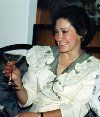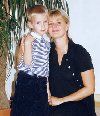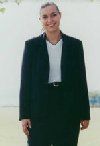Early Detection: A Way To Beat The "Silent Killer"?
Norma Larrea, of Mexico City, was 47 when she got osteoporosis. "I couldn't do my household chores and had pain throughout my body," she recalls. Her doctor did not diagnose osteoporosis. Eventually, after considerable suffering, a specialist in osteoporosis diagnosed her properly and treated her for the disease. Norma was lucky. Although her diagnosis was late, it came before she broke any bones.
Reprinted with permission of Paul S. Sochaczewski
originally published by International Osteoporosis Foundation

Norma Larrea, of Mexico City, was 47 when she got osteoporosis. "I couldn't do my household chores and had pain throughout my body," she recalls. Her doctor did not diagnose osteoporosis. Eventually, after considerable suffering, a specialist in osteoporosis diagnosed her properly and treated her for the disease. Norma was lucky. Although her diagnosis was late, it came before she broke any bones.
Norma Larrea was lucky.
"I was a soccer mum, always driving the kids to sports events and parties," this energetic 55 year old Mexico City woman explains. "Then I got pain throughout my body, in all my bones. I couldn't do my household chores, let alone think about continuing my macram courses."
Norma Larrea had osteoporosis, but her doctor never considered that she might have the bone disease that has been called "the silent killer." He simply gave her analgesics and anti-inflammatory drugs, and told her to take it easy.
But serendipity was on her side. Her husband, a specialist in nuclear medicine, attended a lecture by Dr. Juan Tamayo, one of Mexico's leading specialists in osteoporosis. Immediately Dr. Eduardo Larrea recognized the symptoms and insisted that his wife consult with Dr. Tamayo.
"That was in 1990, and at that time densitometry was very new in Mexico," Dr. Larrea explains. Dr. Tamayo prescribed calcium, magnesium, and alendronate, which Norma had to go to San Antonio, Texas, to buy since it was not available in Mexico.
Today, her bone mass has increased to just below the mean for her age, and Dr. Tamayo expects her bone mass to stabilize above the mean within a year or two.
"I'm a very lucky woman," Norma Larrea says. "My osteoporosis was detected early, before I had any fractures. My bones have recovered their strength. I now swim, and sleep the whole night without pain."
Not everyone is as lucky as Norma Larrea.
"The lack of early detection of osteoporosis causes untold suffering among people worldwide," notes Prof. Pierre D. Delmas, president of IOF-the International Osteoporosis Foundation. "The issue is so important that our 96 member national societies in 56 countries will focus their 1999 World Osteoporosis Day activities on October 20 around the theme of early detection."
What exactly is osteoporosis, and why is early detection so important?
Prof. Ren Rizzoli, chairman of IOF's Committee of Scientific Advisors, from Switzerland, explained how healthy bones are dense and heavy, while osteoporotic bones are light and fragile. "In osteoporosis the bone mass decreases, which increases the risk of broken bones, particularly to the spine, wrist, hip, pelvis and upper arm."

The problem is that diagnosis often occurs after bones have broken.
Following the birth of her first baby, Isabelle Gottschalk-Schmidt of Weimar, Germany, experienced "the worst pain of my life. It lasted weeks and weeks and weeks," she says. "I couldn't even bend over to take my baby out of her crib."
Mrs. Gottschalk-Schmidt, then 25 years of age, said her physician "simply didn't believe me. He told me I had a psychosomatic illness and told me that I developed the pain because I hated my husband and my child."
Finally her grandfather, a retired physician, insisted that she have x-rays. They showed that Isabelle Gottschalk-Schmidt had several fractured vertebrae, due to osteoporosis.
Prof. Helmut Minne, a member of IOF's Board of governance and the physician who treated Isabelle Gottschalk-Schmidt, wasn't surprised. "First, it's criminal how many doctors ignore the obvious that bone and joint pain might be attributable to osteoporosis," he says. "Second, Mrs. Gottschalk-Schmidt's treatment was a classic example of sexual chauvinism in medicine. Women endure it. But they shouldn't."
How then can early detection be expanded?
Early diagnosis is possible using non-invasive bone density scans, which require special equipment but are not frequently used in many countries for a variety of reasons, notably lack of health insurance or government reimbursement. Ordinary x-rays do not accurately measure bone density.
Sometimes it is better to identify people at high risk of osteoporosis and stop the disease before it strikes them.
"We've developed a simple one-minute osteoporosis risk test to help determine whether you're at high risk," explains Mary Fraser, executive director of IOF. "For example, if your mother had osteoporosis, or if you've had irregular periods for more than 12 months you probably should consult with your doctor."

Could early detection have helped Claire Peach?
Miss Peach, of Adelaide, Australia, was in perfect health. She was 17 and hoping to represent her country as a rower in the 1996 Olympics.
But her life changed when she heard a loud crack in her back during a race on the River Murray. She had dislocated her pelvis, and a bone scan revealed that she had osteoporosis. Today, instead of preparing for the 2000 Olympics, Claire Peach now avoids contact sports and adheres to a special high-calcium diet, combined with a regular exercise program.
"I was training so hard that my periods stopped," the young woman, now 25, explains. "I was on a low fat diet and stopped eating any dairy foods, so I wasn't getting much calcium."
"I didn't realize my high level of training was putting my body at such risk," the young woman explains. "I only wish that I had known what I do now. Most kids never think about osteoporosis. I certainly didn't. People need to have respect for their body and seriously think about what they do with it. It has to last you a long time," she says. "I'm okay now, but my competition days are over. But I'll have to be pretty careful when I reach menopause and when it comes time to educate my own children about healthy bones."
One positive side effect of Claire Peach's suffering is that after learning about the likelihood of a hereditary connection to the disease, she encouraged her mother to have her bone density measured. Through this early detection her mother, 55, was diagnosed with osteoporosis and receives treatment.
"Osteoporosis is a disease that can partially be prevented, if you are willing to invest in your bones! According to Elisabeth de Boer, Director of the Dutch Osteoporosis Society. "In general, a healthy life style will help build strong bones. The key to preventing osteoporosis is weight-bearing exercise, such as walking, plenty of calcium, which you can get from dairy products, leafy green vegetables and many calcium-enriched foods, and sunshine, which gives the body the Vitamin D necessary to assimilate the calcium."
"We think people should take charge of their own bodies," explains Tamara Kovatcheva, Head of the Women without Osteoporosis Foundation in Bulgaria. "The world has changed and we shouldn't think of ourselves as patients who are victims. The fight against osteoporosis is a call for empowerment," she says. "We have to take responsibility for our bodies. No one else can do that for us."
This fight can be fun. Yanina Catano, of Comit Mexicano Para el Estudio de la Osteoporosis in Mexico, says that her society is planning a campaign to promote "muvet, literally "move your bones." "Mexicans love to dance," she explains, and part of our World Osteoporosis Day activities will involve public mambo and salsa contests in the central plazas of dozens of Mexican towns."
How serious is osteoporosis?
About one in three women and one in eight men over the age of 50 worldwide risk having an osteoporotic fracture during their lifetimes, according to IOF. Worldwide, the increase in the number of osteoporotic hip fractures is estimated to increase from 1.7 million in 1990 to 6.3 million in 2050. The greatest increase is likely to come in Asia.
In the Western world, the risk of dying following a hip fracture is greater than the risk of dying from gastric or pancreatic cancer. The life-time risk for women of dying from hip fracture complications is similar to the risk of dying from breast cancer. In Europe and the United States, the lifetime risk of hip fracture in men is greater than the risk of cancer of the prostate.
Early detection of low bone density could significantly reduce the impact of osteoporosis, according to a new WHO study.
Dr. Harry K. Genant, University of California San Francisco, chairman of the task force that produced the WHO Strategy on Osteoporosis, said "Doctors around the world often fail to diagnose osteoporosis correctly. Bone pains and fractures are attributed to normal problems of ageing, rather than to a specific disease. This situation could be changed radically if doctors and patients learned to recognize the risk factors of osteoporosis and if it was easier for patients to have bone mineral density examinations."
The interim report recommends increased education of the public and healthcare providers; improved access to densitometry, improved care and education.
"The message is simple," says Mary Fraser. "Take responsibility for your own body. Talk to your doctor about your concerns. It's your body, after all."
For more information please contact: Paul Sochaczewski, IOF Communications Advisor
May, 2000
S1E4: Dr. Kristina Adams-Waldorf: Pandemics, pathogens and perseverance
July 16th 2020This episode of Pap Talk by Contemporary OB/GYN features an interview with Dr. Kristina Adams-Waldorf, Professor in the Department of Obstetrics and Gynecology and Adjunct Professor in Global Health at the University of Washington (UW) School of Medicine in Seattle.
Listen
Study shows a healthy prenatal diet could be upstream obesity prevention strategy
December 26th 2024"Our findings support the recommendation of a healthy diet based on the current guidelines (as measured by the HEI) during pregnancy, since it may reduce patterns of infant growth outside reference ranges."
Read More
Early pregnancy cannabis use high in states with recreational legalization
November 11th 2024A population-based time-series analysis California before, during and after legalization show a rising trend in women using cannabis while pregnancy especially when the state has legalized the drug.
Read More
